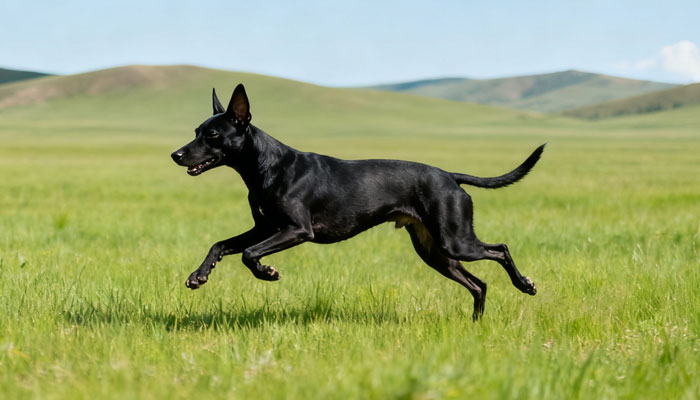Physical Characteristics of the Basenji

The Basenji is a hunting breed typified by its solid compactness and quite rare barking—it is not that it can’t make a sound, but due to the dog’s instinct of silence while hunting. It has upside-down triangle-shaped ears and an extremely sensitive hearing sense.
I. Basenji Body Structure
A male Basenji’s perfect height is 17 inches at the shoulders. Its length from the chest to the end of the rump is also 17 inches, and it weighs roughly 24 pounds. For females, 16 inches is the ideal height at the shoulder with length adhering to the height measurement and weight of about 22 pounds. Those whose height and weight are within this range show a light and agile physique.
II. Basenji Head
The head is very dashing and held vertically. Eyes are dark hazel to dark brown, almond-shaped, and set slightly obliquely for a broad field of vision, with dark rims. Ears are small, high on the skull, somewhat helmet-shaped, fine in texture, and pointing straight ahead. The skull is flat, nicely shaped, of medium width, tapering down to the eyes; the muzzle narrows from the eyes to the nose, with a distinct stop. The muzzle is a little shorter than the skull, is not heavy or light, with a rounded jawline. The forehead is covered with fine, plentiful wrinkles when the ears are upright. The side wrinkles are also important but here the teaching must not be exaggerated so that they reach the throat. The puppies have very noticeable wrinkles as they do not have deep shading and strong pigmentation, and they are often tricolor or spotted. A black nose is what we want to see. The teeth form an even row and the jaws meet in a scissor bite.
III. Neck, Topline, and Body
The neck is long enough with a characteristic crest, at the base full and it joins the shoulders in a gentle slope. The top line is still even, the back is short, and the overall dimensions are proportional. The body is tightly woven, and the waist at the rear is clearly visible. The ribs are of medium depth, oval in shape and extend to the elbows. The forechest juts out a bit, going beyond the shoulder joints; the chest width is average. The tail is positioned high on the backline, tucking under the back and going up in a tight coil.
IV. Basenji Forequarters
The Shoulder is moderately sloping, and its length is about the same as the upper arm. The elbows are right next to the chest, the forearms are straight, and the bones are of good quality, with muscles that stand out in shape. The pasterns are the correct length, solid, and give off a springy vibe. The feet are small, oval-shaped, and tight, the pads are thick and the toes are arched. Dewclaws are usually removed.
V. Basenji Hindquarters
Hips are the moderately wide, solid, and well-developed muscles. The kinks are low, and are neither turned in nor out. The back of the leg is long, and the bend at the hip joint is moderate. The hind feet are like the front feet.
VI. Basenji Coat Color
Coat is short and fine, and the skin is very smooth. Colors are fawn, black, tricolor (black and fawn), and spotted (black spots on a fawn ground). No matter what color they are, all have white on their feet, chest, and tip of the tail. White legs, white stripes, and a white ruff are just optional, and white should not be more than the main color. Color and markings of the coat have to be deep, clear, and crisp and there should be distinguishable lines between the black, red, spots, or stripes.
VII. Basenji Gait
The gait is energetic and easy trot with a long stride and smooth movement at all times running the topline is kept level. When viewed from the front or rear during movement, whether going straight or turning, the forelegs appear to be vertical from the shoulder down to the foot, and the hindlegs from hip down to the footpad, and there slackness is absent. Feet turn slightly toward the axis of the body and this inclination becomes more apparent as the speed is increased.
VIII. Basenji Temperament
The Basenji is one of the most intelligent and independent breeds, yet he also has a friendly, but vigilant nature. When encountering strangers, he acts in a way to avoid them before they have a chance to approach him.
admin
-
Sale!

Washable Pet Cooling Pad for Cats and Dogs
$10.99Original price was: $10.99.$9.99Current price is: $9.99. This product has multiple variants. The options may be chosen on the product page -
Sale!

Washable Cat Window Hammock Cooling Bed
$23.99Original price was: $23.99.$22.99Current price is: $22.99. -
Sale!

Tropical Amphibian Rainforest Tank, Lizard Cage
$38.99Original price was: $38.99.$36.99Current price is: $36.99. -
Sale!

Silent 4-in-1 Waterproof Charging Dog Hair Trimmer
$49.88Original price was: $49.88.$47.99Current price is: $47.99.